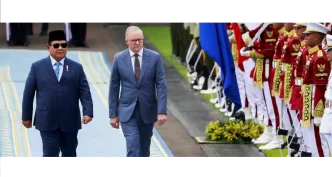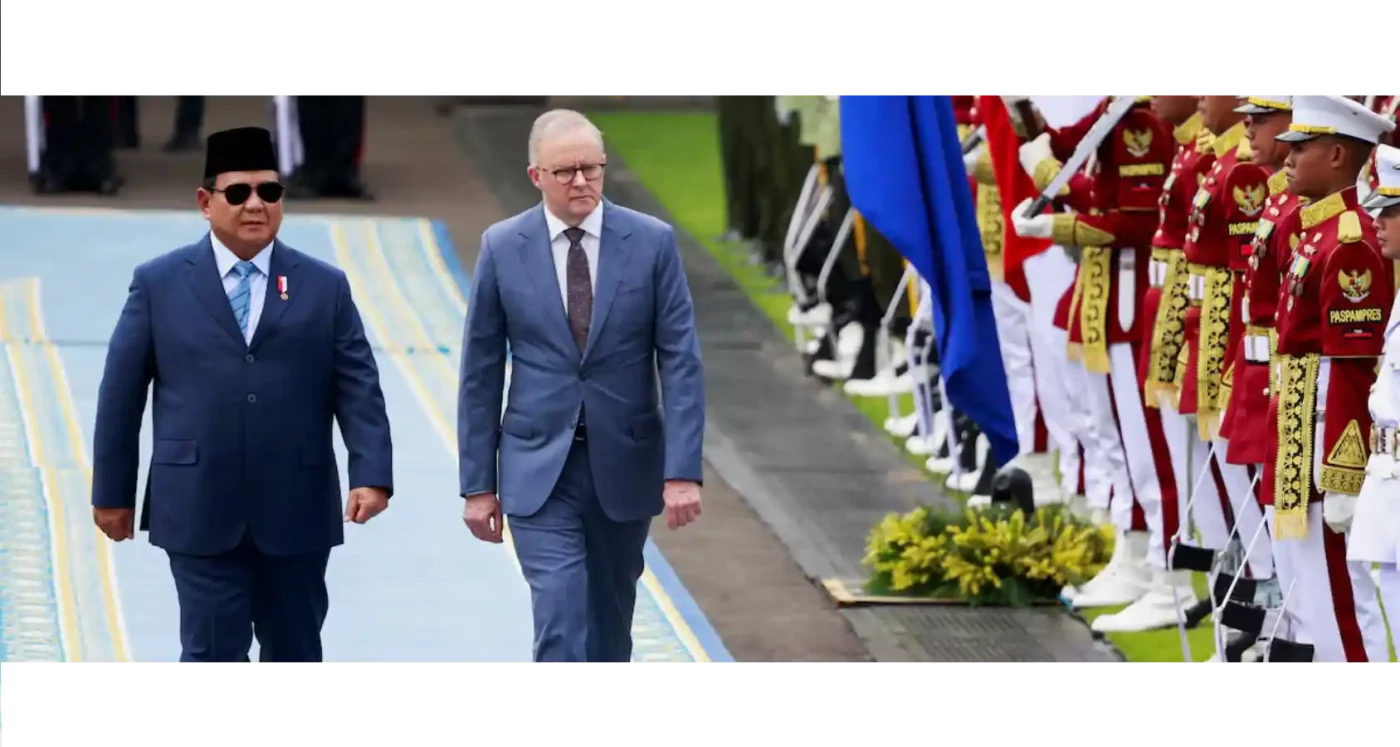Indonesian President Prabowo Subianto hosted Australian Prime Minister Anthony Albanese at the Merdeka Palace in Jakarta on May 15, 2025, marking a significant moment in the ongoing relationship between the two nations. The visit, Albanese’s first international trip after his second-term inauguration just a day prior, underscored Australia’s prioritization of its partnership with Indonesia amid evolving regional dynamics in the Indo-Pacific.
The meeting, characterized by grand ceremonial gestures and personal warmth, saw both leaders reaffirm their commitment to deepening cooperation in defense, digital technology, energy transition, education, and the green economy. Yet, as analysts note, while personal rapport offers a strong foundation, geopolitical challenges and differing strategic priorities could test the durability of this renewed alliance.
A Symbolic Welcome
President Prabowo welcomed Albanese with an elaborate display of hospitality at the State Palace, featuring a military motorbike convoy, a guard of honor, and nearly six dozen cavalrymen. Some 200 secondary school students waved the flags of both nations, symbolizing the cultural and diplomatic bridge between Jakarta and Canberra. The gesture was more than ceremonial—it reflected Indonesia’s intent to position itself as a key partner in Australia’s foreign policy framework.
Following the formalities, the two leaders held a private discussion before addressing the press. “It is a great honor for Indonesia to receive the maiden visit of PM Albanese just one day after his inauguration” said Prabowo during the joint press conference. He emphasized the inevitability of their shared geography, adding, “Australia and Indonesia are fated to be neighbors, and good neighbors will help each other during times of difficulties. I am personally determined to keep good relations, and we are grateful that Australia sees us as its close friend.”
Albanese reciprocated the sentiment, highlighting the importance of the partnership. “No relationship is more important to Australia than this one, and no nation is more important to the prosperity, security, and stability of the Indo-Pacific than Indonesia” he asserted. He framed the visit as a continuation of a deliberate policy to prioritize Jakarta, a stance he first articulated during his 2022 visit to Indonesia as a newly elected prime minister.
A History of Personal and Political Bonds
The personal chemistry between Indonesian and Australian leaders has often played a pivotal role in shaping bilateral ties. Albanese’s relationship with Prabowo’s predecessor, Joko “Jokowi” Widodo, was marked by symbolic gestures, such as cycling through Bogor’s botanical gardens on bamboo bicycles in 2022 and sailing around Sydney Harbor in 2023. These moments of camaraderie helped reset relations after a series of tensions in the 2010s, including the 2013 spying scandal involving then-Australian Prime Minister Tony Abbott and Indonesian President Susilo Bambang Yudhoyono, and the 2015 execution of two Australian citizens convicted of drug trafficking under Jokowi’s administration.
While some observers have speculated that Albanese’s absence from Prabowo’s inauguration in October 2024 might have caused a minor diplomatic hiccup, the warmth displayed during this visit suggests otherwise. Susannah Patton, a researcher at the Australia-based Lowy Institute, described the atmosphere as “extremely positive.” She noted, “Prabowo is clearly a more personable, warm, and confident leader compared with Jokowi. As a defense minister, he was already well-disposed to Australia and Western countries, which is something Australia would really welcome as it promises a more mature strategic dialogue between the two countries.”
Prabowo’s personal gestures, including an impromptu visit to Albanese’s hotel on the evening of May 14 and an invitation to his Hambalang estate for horseback riding, further underscored his intent to build a strong rapport. Though the horseback riding has yet to take place, these overtures highlight a continuity of the personal touch that has come to define Indonesia-Australia relations in recent years.
Strategic Cooperation and Shared Goals
Beyond the personal dynamics, the meeting produced tangible outcomes. A joint communiqué outlined enhanced cooperation across multiple sectors, accompanied by a four-year action plan for the Indonesia-Australia Comprehensive Strategic Partnership. Defense ties, a cornerstone of the relationship, were a focal point, with both leaders expressing a desire to bolster joint exercises and intelligence sharing. Digital technology and the green economy also emerged as priority areas, reflecting shared interests in addressing climate change and harnessing innovation for sustainable growth.
Education exchanges, long a pillar of cultural ties, received renewed emphasis, with discussions on expanding scholarship programs and vocational training initiatives. Energy transition, particularly Indonesia’s push for renewable energy infrastructure and Australia’s expertise in green technologies, was highlighted as a potential area for collaboration. These commitments signal a mutual recognition of the transformative changes underway in the region, as Albanese noted during the press conference, urging that the partnership must “match the scale of the growth and transformation” in both nations.
Geopolitical Challenges on the Horizon
Despite the optimism, analysts caution that personal rapport alone cannot guarantee seamless cooperation. Indonesia and Australia often navigate differing geopolitical currents, particularly regarding the United States-China rivalry in the Indo-Pacific. Australia’s close security alliance with the US, exemplified by its participation in the AUKUS pact—a trilateral agreement with the US and the UK to acquire nuclear-powered submarines—has occasionally strained ties with Indonesia, which adheres to a non-aligned foreign policy. Jakarta’s frustration over not being informed in advance about AUKUS in 2021 remains a point of contention, with some Indonesian officials viewing the pact as a counterweight to China that could escalate regional tensions.
Conversely, Indonesia’s economic and security ties with China and Russia have raised concerns in Canberra, where domestic voices often question Jakarta’s balancing act between major powers. Patton of the Lowy Institute acknowledged these challenges, stating, “Challenges in deepening Indonesia-Australia ties will persist, and economic cooperation will still be an uphill battle despite the good sense.” She pointed to structural differences in economic priorities—Indonesia’s focus on resource exports versus Australia’s emphasis on services and technology—as potential barriers to closer integration.
Moreover, regional security issues, such as maritime disputes in the South China Sea and the stability of the broader Indo-Pacific, continue to test the alignment of Jakarta and Canberra’s strategic visions. While both nations share an interest in a rules-based order, their approaches to achieving it often diverge, with Australia leaning on Western alliances and Indonesia advocating for ASEAN-led multilateralism.
Economic Dimensions and Future Prospects
Economic cooperation, while a stated priority, remains an area requiring significant effort. The Indonesia-Australia Comprehensive Economic Partnership Agreement (IA-CEPA), implemented in 2020, has boosted trade by reducing tariffs and easing investment barriers, yet bilateral trade volumes still lag behind Australia’s partnerships with other regional players like China and Japan. Indonesia’s vast market potential, with a population of over 270 million, offers opportunities for Australian businesses in agriculture, education, and infrastructure, but bureaucratic hurdles and regulatory inconsistencies in Indonesia often deter investors.
Australia, meanwhile, seeks to diversify its economic dependencies away from China, viewing Indonesia as a critical alternative for supply chains in minerals and energy. Joint ventures in critical minerals like nickel, essential for electric vehicle batteries, could become a cornerstone of future collaboration, especially as both nations aim to capitalize on the global shift to renewable energy. However, aligning regulatory frameworks and ensuring mutual benefits will require sustained dialogue beyond high-level visits.
Looking Ahead
As Prabowo and Albanese chart the next chapter of Indonesia-Australia relations, the foundation of personal trust and shared strategic interests offers a promising start. Yet, the complexities of regional geopolitics and economic integration suggest that goodwill alone will not suffice. Both leaders face the task of translating ceremonial gestures and joint statements into actionable policies that address mutual concerns while navigating their respective domestic and international pressures.
For now, the image of Prabowo driving Albanese in a golf cart at the Merdeka Palace serves as a lighthearted symbol of their budding partnership. Whether this camaraderie can withstand the inevitable tests of time and politics remains an open question, one that will shape the Indo-Pacific’s future as much as the bilateral relationship itself.
















